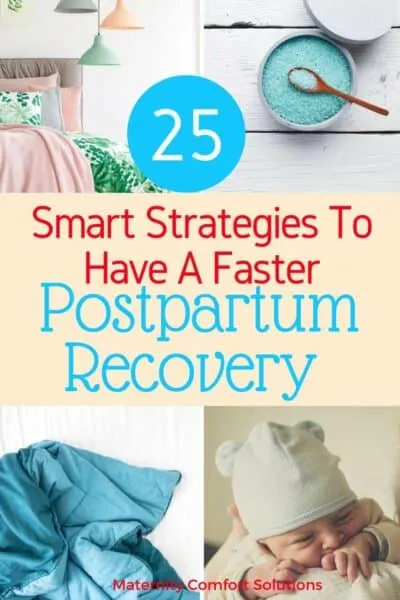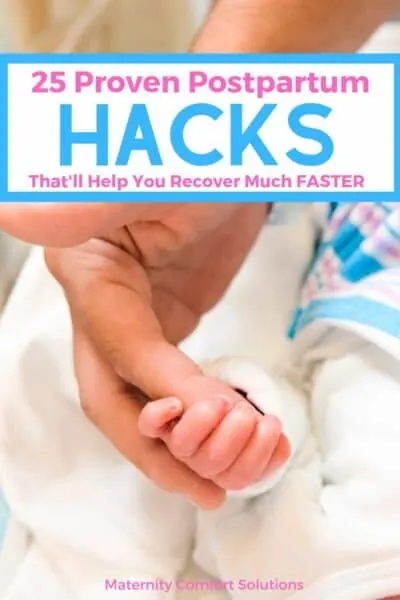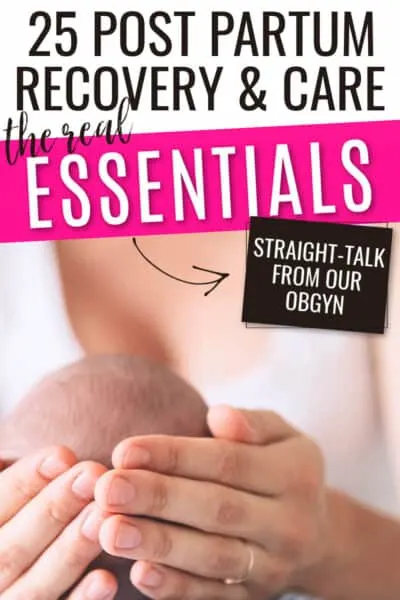Updated March 15, 2023
Have you looked at a list of postpartum recovery essentials and wondered what do I really need?
You are not alone.
Figuring out what to expect postpartum and what you’ll need to get through it (and make it easier), can feel overwhelming.

As if there isn’t enough to deal with in the third trimester of pregnancy as it is.
When I had my first baby I was totally unprepared for my postpartum recovery.
My son was born 4 weeks early, I had an emergency c-section.
Unprepared doesn’t quite capture the shock and awe I was left in after having my son.
It was not fun walking into CVS pharmacy with only socks on my feet (they were too swollen for shoes) in the rain to get “supplies” on our way home from the hospital.
That was not one of my best days.
You are not going to have a day like that, because you are going to be prepared.
I’m very lucky now that my better half is an OB/GYN that has delivered thousands of babies and has cared for thousands of postpartum moms.
He knows about all the “things” going on down there after having a baby, he explains what to expect here.
He also knows the products his patients said were the most helpful to have in their postpartum care kits at home.
We get it. So we are sharing the essential products you’ll want and need to make your postpartum easier.
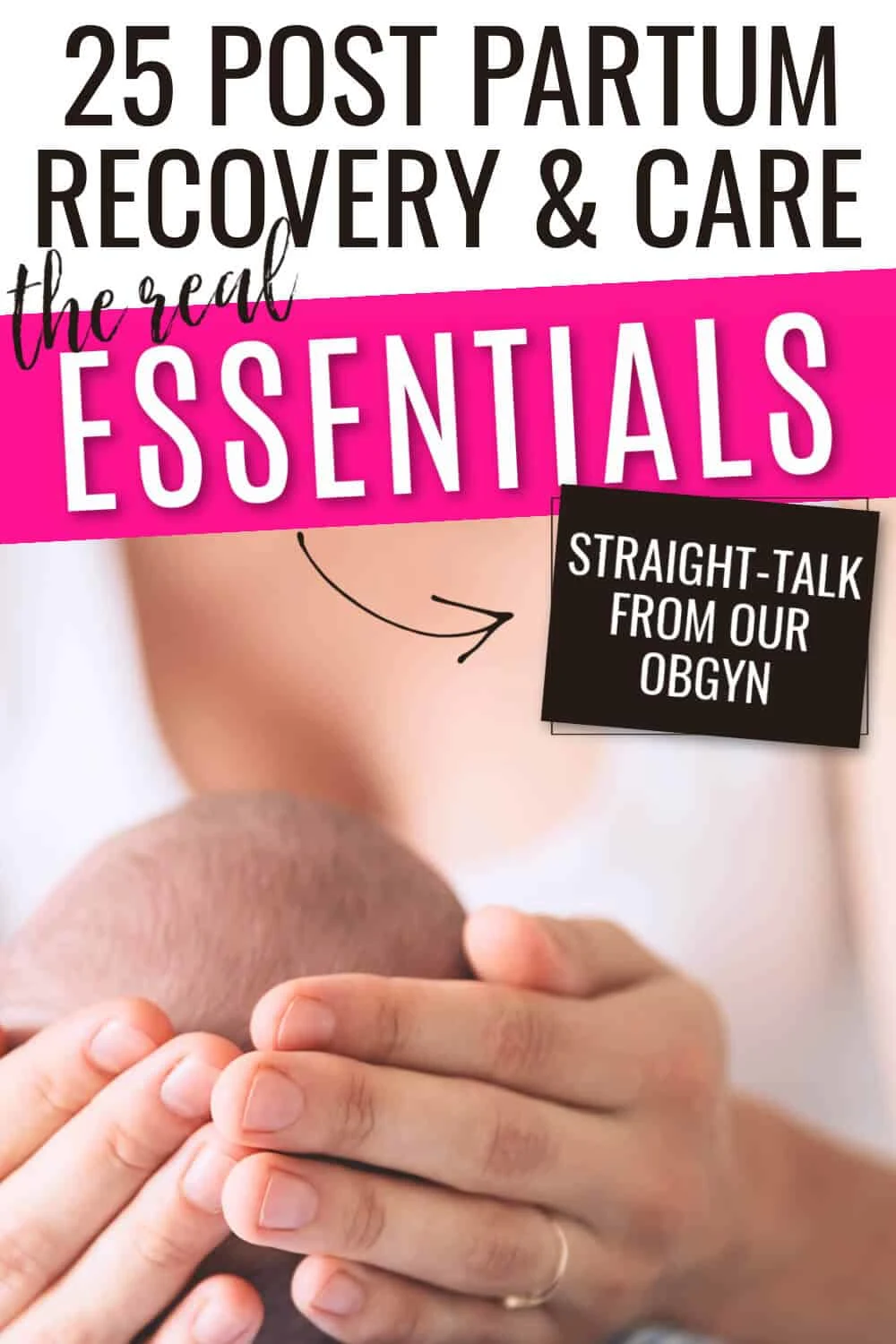
The key to a smooth recovery is to have as many of these things ready as possible before the baby arrives.
When you are discharged home from the hospital with your baby, you are going to be sore and exhausted.
Whether you have a vaginal delivery or a c-section, you’ll need time to let your body heal.
Be sure to read part 1 of our series so you’ll know what to expect physically and what complications to look out for in the first 6 weeks after delivery.
25 Postpartum Recovery Essentials for New Moms
1. Large maxi-pads:
the first thing you’ll need in your DIY postpartum care kit is pads.
Get the super long ones or adult diapers.
I preferred the super-long pads.
These are the ones that worked best for me
Your vaginal discharge will be heavier than your period, so you’ll be glad if you get the thickest and longest ones possible.
2. Large comfy postpartum underwear.
You will likely be very sore and swollen.
I had an emergency c-section with a midline incision, never saw that coming, so I was so grateful for the advice to get big comfy underwear that wouldn’t dig in anywhere.
If you use the hospital ones, the mesh is very loose but tight enough to hold the pads in place.
Postpartum underwear is not just available in hospitals.
These are the underwear our readers love the most.
You will want to put comfort over cute for several weeks postpartum, and these are so comfortable and don’t ride up or get tight.
3. Stool Softener
Don’t skip this one.
If the nurse in the hospital offers you a suppository to help you go, take it.
Going that first time after you have a baby, whether vaginal or c-section is hell.
You’ll want to make it as easy as possible.
Do not strain to make yourself go.
Just one thing to keep in mind, if you had a 4th-degree tear, suppositories should not be used, and if you need to use one talk to your provider to determine if and when you can use a suppository.
You do not want to disrupt any of the stitches.
Your nurse will know this but take this upon yourself to remember as things do get busy on the postpartum floor.
You’ll want to have stool softeners at home too.
4. Medicated pads like Tucks for Hemorrhoids:
Another post-pregnancy gift many women get, myself included, is hemorrhoids.
Tucks or any of the generic varieties will work fine.
They have witch hazel in them which is magic for the relief of hemorrhoid pain.
5. Comfy Socks:
If you are like most women postpartum, you will likely have swelling in your feet and ankles after delivery.
I couldn’t wear shoes for days. I really liked wearing soft fuzzy postpartum socks.
They are super stretchy and didn’t feel restrictive.
6. Nike Slide on Sandals:
These are the absolute best shoes for the postpartum recovery period.
They are non-slip and super comfortable.
I’d bring them to the hospital in your bag.
Perfect for when you step out of the shower or want to walk around.
You can slip them on in a second for that 2 AM feeding/diaper change.
If you have some swelling in your feet and ankles, they will likely still fit fine.
They come in a huge variety of colors too.
You can read the reviews and check the price on Amazon.
7. Compression Socks:
For the first one to two weeks, you will find yourself urinating a lot in the middle of the night.
This is because of the fluids you received during your labor and delivery.
During the day this fluid will pool in your ankles.
Assuming you are not dealing with swelling related to toxemia, this fluid will then mobilize out of your ankles when you lie down and your ankles are elevated.
You will find yourself urinating a great deal during the night as this fluid can return to your circulatory system and be filtered out through your kidneys.
When you are lying flat, gravity is not impeding the flow of blood up your legs and back to your heart.
Usually, by two weeks postpartum, the excess fluid in your lower extremities will be gone.
To further facilitate the removal of fluid from your lower extremities, you can also wear mild compression stockings to compress surface veins in the lower legs.
8. Ice packs:
After a vaginal delivery, especially if you pushed for a while and had a vaginal tear, there can be nothing more comforting and therapeutic than ice packs applied directly to the perineum.
Labial swelling can be quite extensive even before delivery. After your delivery, the swollen tissue needs time to recover.
Combine ice packs with Dermoplast spray after a sitz bath to avoid further swelling, promote healing, and avoid infection.
This approach should give you tremendous relief during the first 24 to 48 hours after delivery.
9. Nursing Bra/Nursing Pads/Nipple Cream:
If you planned to breastfeed, there is no doubt you will already have prepared yourself for what to expect.
Hopefully, you have talked with others who have breastfed and taken full advantage of the resources available to you at your provider’s office and in the community.
Among the women who breastfeed, one of the key indicators of whether they continue to breastfeed is how prepared they were at the outset.
Breastfeeding requires organization and establishing a consistent daily routine.
Without the necessary preparation, a rewarding experience can quickly become overwhelming.
Make sure your home is prepared for breastfeeding when you get home from the hospital.
Purchase all the necessary supplies and decide on a designated place in your home where you will spend most of your time breastfeeding so that your baby will become familiar with your routine.
When you are postpartum and have just arrived home you want your life to be planned out as much as possible.
10. Loose Comfy Clothes:
You’ll probably be spending a lot of time on the couch or in bed feeding and holding your new baby.
You’ll want to be as comfortable as possible.
Plan to wear loose-fitting clothes.
Yoga pants and sweats will likely be your go-to for the first couple of weeks, at least.
If you are nursing, you’ll want a couple of nursing tops to make it as easy as possible to nurse.
11. Epsom salt:
Epsom salt is amazing for helping to relieve vaginal pain and inflammation.
It should absolutely be on your postpartum recovery essentials list!
You can take sitz baths to help ease the swelling and pain. Be sure to get the OK from your doctor, but after that soak, soak, soak.
Epsom salt is also excellent for relieving muscle aches and pains.
If your back muscles are sore from labor or from sitting up nursing, soaking in a warm bath with Epsom salt can help.
12. Dermoplast Pain Relieving Spray:
Dermoplast is also recommended by many moms and Doctors for relieving pain after delivery.
Get the blue Dermoplast can.
Take the peri-bottle home from the hospital, you’ll still want to rinse off with that first, then use the Dermoplast spray to relieve your pain.

13. Freezer meals/Take out menus/Finger foods:
Having freezer meals prepared and ready to go for when you come home will be a huge time-saver.
I did not do this and I regretted it.
I had a c-section and my son was born early and had trouble eating, and was colicky.
By dinner time, I was totally fried.
Don’t make my mistake.
Prep those freezer meals.

You will be hungry and you’ll be stuck at home for a while.
Get the take-out menus from your favorite restaurants so you can order the comfort foods you enjoy.
Think finger foods.
Your new bundle of joy may want to be held all the time or may nurse frequently.
That may require you to eat while holding your baby.
Finger foods are much easier to eat with one hand.
14. Stuff to make you feel more human:
Stock up on your favorite shampoo, nail polish, hair color, snacks, and lipstick.
When you first come home with your baby, you usually don’t go out much except to the pediatrician for several weeks.
You’ll be glad you stocked up on the things that make you feel more human.
Even if you put off guests for a while, which we strongly recommend, you’ll still have people that “just stop over for a minute” to see the new little one.
Having your favorite lipstick to throw on will make you feel a little more human when the doorbell rings.
15. Batteries and chargers for phones/tablets:
Make sure you have batteries for the remotes, your camera, and the chargers for your phone and tablet.
Nothing is worse than a sleeping baby in your arms and a dying phone or tablet.
Put an extra charger by the couch or bed, you’ll be glad you did.
16. Maternity Belt/Belly Band:
If you developed Diastasis Recti during your pregnancy (see part 1) the postpartum use of a belly band (also known as a maternity support belt, abdominal binder, or pelvic support belt) can be very helpful.
Diastasis Recti is a bothersome condition where the abdominal muscles separate in the midline.
This can lead to a tremendous amount of laxity of the abdominal wall.
This is the result of either a predisposition due to a weak abdominal wall or a result of multiple pregnancies (twins, triplets).
Most often the redundant tissue and attenuated muscles in the abdominal wall will tighten up in time.
However, there are rare circumstances where the tissues never regain their tone.
Procedures can be performed to remove the redundant tissue and tighten the midline abdominal muscles.
When this is required a general or plastic surgeon is consulted to repair the abdominal wall to restore the abdominal tone.
This may also be necessary, in some instances, to restore normal bodily functions including maintaining proper posture and normal bowel function.
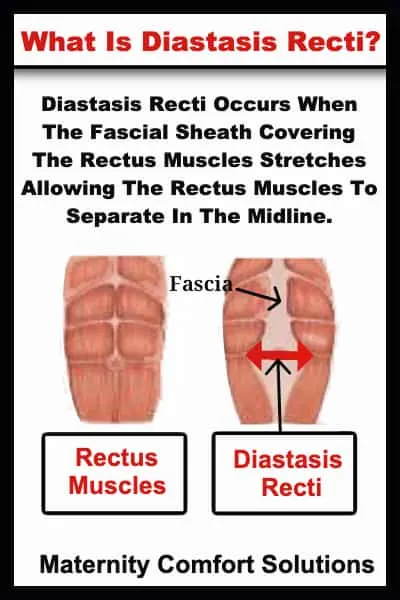
17. Baby Swing:
A baby swing is the one item that most women who have had a child will tell you they could never do without.
You will always need to be with your baby when he or she is in the swing; however, simply being able to put your child in the swing can be a lifesaver when you just want to sit down and rest.
As a rule, babies love swings and often fall sound asleep.
The 4moms MamaRoo 4 Baby Swing is my choice because can’t live without the item.
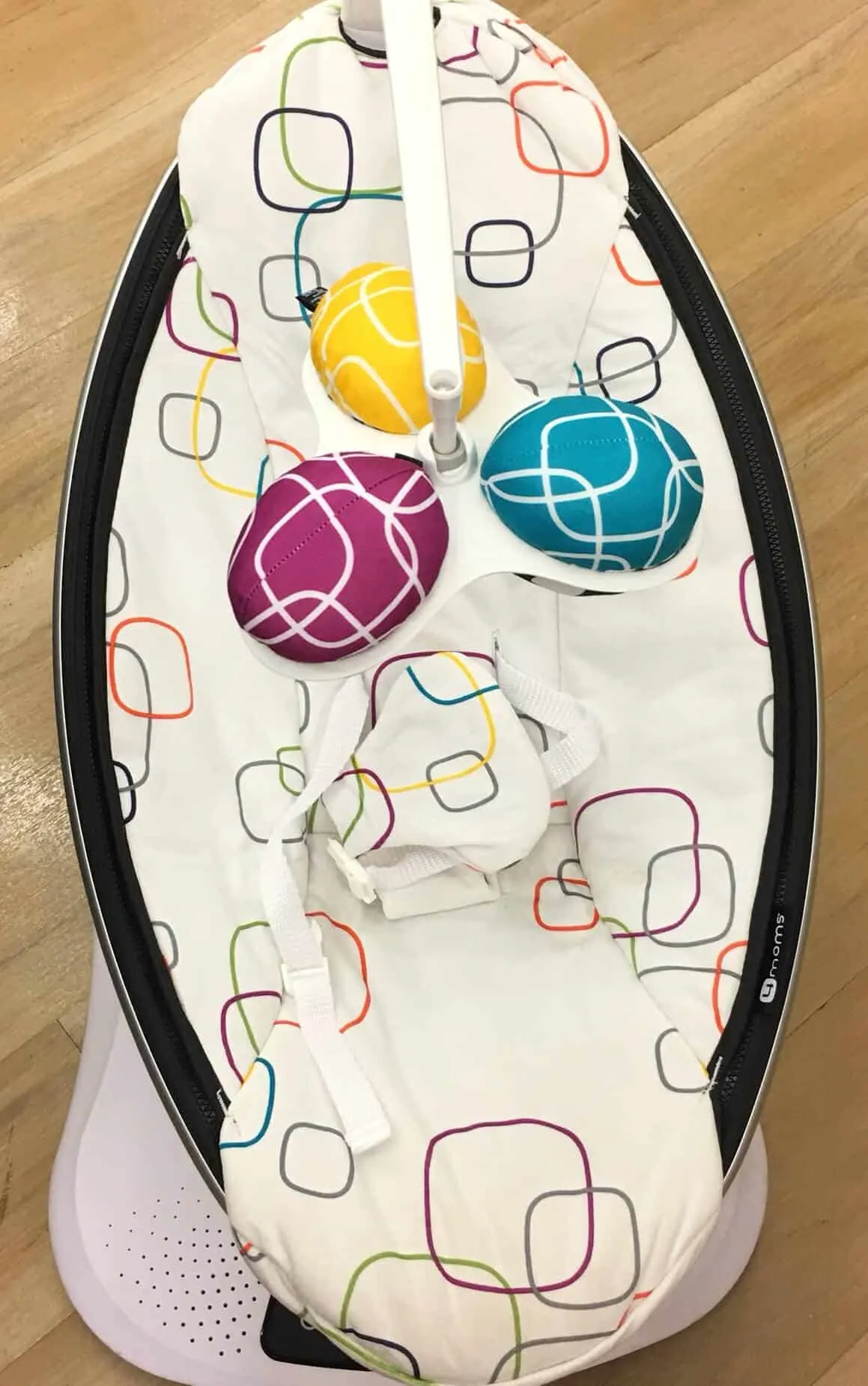
Photo Credit: Maternity Comfort Solutions
I used this swing every day. If you have a colicky and gassy baby, a baby swing can make all the difference.
If you need to take a quick shower, bring the swing in the bathroom, and you are set.
I love the compact size of the 4Moms swings.
It is a little bit pricier, but I think the price is worth it.
You can always use it if you have another baby or they maintain their value really well, you could sell it when you were done with it and get a good chunk of your money back.
It comes in a few different colors. Mine is white with colored circles. I posted one below from Amazon that is black.
You can see all the colors and options here
Postpartum Recovery Survival Advice:
18. Sleep, Sleep, Sleep:
Nap when you can. One of the best ways to speed up healing is with rest.
Rest when the baby sleeps.
If you have a pregnancy pillow this is the time to use it.
Everything else can wait. There is no task more important than rest when you first come home.
Take advantage of anyone who offers to help and be sure that your partner is doing their part to help you get some much-deserved and needed rest.
19. You can say “No” to visitors.
Everyone wants to come and see the new baby.
Though you want to show off your little one, you may be flat-out exhausted and sleep-deprived.
You don’t have to be on the entertainment committee. You can simply say “Not today”.
There is nothing more important than your resting and healing.
Your friends and family will understand.
20. Feel free to ask for help!
You need to be careful to not overdo it when you come home. Ask for help when you need it.
Take help when it is offered. Pushing too hard will only make your postpartum recovery take longer.
Your body needs time to heal.
Consider the services of a postpartum doula.
A postpartum doula is there to take care of you and help you with your new baby.
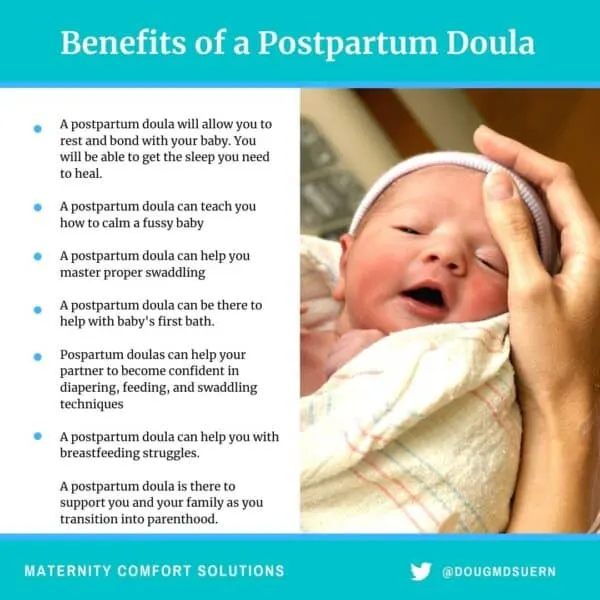
21. Don’t be afraid to call the doctor:
During your postpartum recovery, which encompasses the first 6 weeks after delivery, many possible medical concerns could come up.
This includes bleeding problems, infections (urinary tract, mastitis, uterus, incision), blood clots in thighs/legs, breastfeeding concerns, etc.
As we shared in Part 1, these are all urgent medical matters that should be addressed promptly.
Your doctor and his/her medical group make arrangements to cover urgent issues day and night.
Never be afraid to call your doctor about these concerns as they can become serious quickly. Diagnosing postpartum problems and treating them early is essential. -Dr. Doug Penta, MD
22. Babywearing:
Babywearing is a great way to free up your hands so you can do things.
You can keep your baby close while you make dinner, do laundry, or take a walk with your other kids.
Being self-employed meant I didn’t get a full 6 weeks to recover.
I was back working two weeks after my cesarean delivery and it only happened because of babywearing.
Babywearing has many benefits for both you and your baby during the postpartum period.
I certainly do not advise anyone to return to work two weeks postpartum. – Dr. Penta
But the reality is that many moms have too.
Babywearing is a great option if you work from home or can take your baby to work with you.
This is the baby carrier I used when working.
Here are several baby carriers to consider:
23. Breastfeeding is NOT Easy:
My son was born early, he was a sluggish eater and he wasn’t great at latching on.
I ended up with blood blisters on my nipples…ouch!
I pumped and nursed through the pain for several weeks and it didn’t get easier.
We decided to switch to formula and it was the best decision I ever made.
It took so much pressure, pain, and fear off my shoulders.
You will receive many unsolicited opinions, and ultimately do what you want to do.
One thing that did help me was using a nursing pillow.
I had a midline c-section incision that really hurt when anything would touch it, so the pillow helped keep the baby off my belly for those first few weeks.
Resources if you are struggling with breastfeeding and want to continue nursing:
You can take this 90-minute online breastfeeding course right from your couch
If you have not had your baby yet, go and take this breastfeeding course!
It will help you to be prepared to breastfeed.
If you are struggling with breastfeeding before you throw in the towel take this course!
The course can really help you if you are having a difficult time nursing.
The instructor is a Certified Lactation Educator through CAPPA.
The course comes with a troubleshooting guide to help you with the most common issues that could run into.
If you want to switch to formula feeding or formula feed from the beginning here are a few resources you may find helpful:
If you are struggling with a low milk supply, know that it is very common.
It is important to increase how much water or other fluids you drink.
A major cause of low milk supply is dehydration.
Some breastfeeding moms have added oat milk to their diet to get the benefits of the oats ( which may help increase milk supply) and the increase in the number of fluids they drink.
24. Postpartum anxiety is real and normal.
Try using a weighted blanket to get relief!
Being scared and anxious when you first come home with your baby is normal.
I was so afraid something would happen to him.
I watched him like a hawk when he slept.
It is going to be OK, try to relax and enjoy your little one.
During the past few years, weighted blankets have become very popular for the management of postpartum anxiety.
The weight of the blanket simply makes you feel secure.
How does a weighted blanket reduce anxiety?
It is believed that the deep pressure stimulation of a weighted blanket sends impulses to the central nervous system that helps relieve anxiety.
Are weighted blankets safe?
Weighted blankets are safe to use postpartum. Make sure to choose the correct size and weight.
The blanket you choose is based on your size and weight and not the size of your bed.
Can a weighted blanket be too heavy?
Not if you are comfortable. Some like a heavier blanket than others.
It is best to talk with your provider or occupational therapist about what weight is best for you to help manage your anxiety.
25. Do only the things that must be done for at least the first week:
If it isn’t about rest, bonding, feeding, changing your baby, or spending time with your other children, it can wait.
Visitors can wait.
The laundry can wait.
Cleaning can wait.
Your only responsibility is to heal and take care of your little one.
Let people take care of you.
Make sure you have some things to do that you enjoy.
Get Netflix or Amazon Prime Video, books you enjoy, podcasts you love…things that are just for you!
What postpartum Essentials does the hospital provide?
While this will vary from hospital to hospital most hospitals provide these items to new moms after giving birth:
- Maternity pads (for bleeding after birth)
- Nursing pads (for breast milk leakage)
- Breastfeeding support/information sheets
- Nipple cream
- Ice packs for perineal pain relief
- Sanitary wipes and warm washcloths to clean your body post-birth.
- Peri bottles (for cleaning your perineum after going to the bathroom)
- Feminine items like panty liners, pads, and extra underwear.

